I started making no-knead bread in 2010 and it has continued to be my favorite way to make homemade bread because it’s incredibly simple, it doesn’t require a lot of effort, and it makes the most deliciously crusty bakery-style bread ever. To make this no-knead bread recipe you only need four ingredients (including water) and a little bit of time. No fancy equipment or techniques needed!
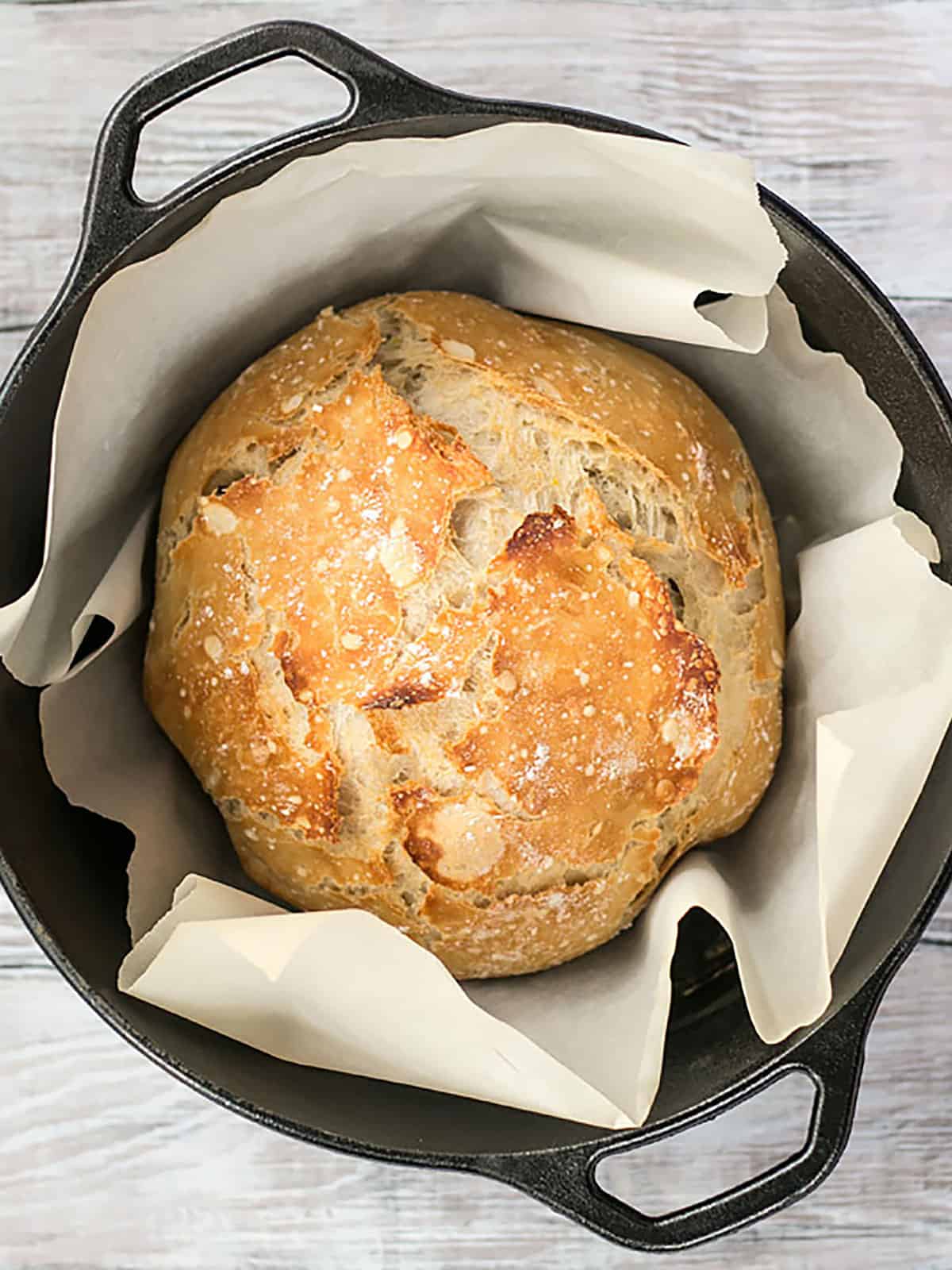
This post contains some affiliate links, which means that we make a small commission off items you purchase at no additional cost to you.
“I’ve made this twice and it was amazing! Hard to believe something so simple can come together to be something so amazing!”
-Melissa
What Is No Knead Bread?
No-knead bread is an ancient technique for making delicious loaves of bread by utilizing a long fermentation time to develop the gluten the flour instead of hand kneading. Gluten is the protein that gives bread its strength, allowing it to rise into a fluffy loaf, and have that deliciously chewy texture. Kneading bread dough develops gluten quickly, but is quite labor-intensive. If given enough time, yeast can develop the gluten in the dough without the need for manual needing.
Ingredients for No Knead Bread
The best part about this no-knead bread recipe is that it only requires four ingredients, including water, and you still get an incredibly flavorful bread. Here’s all you’ll need to make your own homemade no-knead bread:
- Flour: Our version of no-knead bread was developed using all-purpose flour because that is what we most commonly have on hand. That being said, using bread flour will create even better results. Just keep in mind that bread flour tends to absorb more water than all-purpose flour, so you may need to adjust the ratios slightly.
- Yeast: For this type of bread, we use instant yeast or bread machine yeast, both of which do not need to be activated first by proofing in warm water. You can simply add them to your dry ingredients and go!
- Salt: Without the proper amount of salt, homemade bread will have no flavor, so it’s imperative that you do not skip the salt.
- Water: Water hydrates the flour to create the dough. Because this technique uses a longer ferment time, you can use room-temperature water and you do not have to “wake up” the yeast with warm water. The yeast will have plenty of time to activate as it rests.
What Kind of Yeast to Use
It’s very important to use the correct type of yeast for this recipe. Instant yeast and bread machine yeast are special because they do not require mixing with warm water to “wake up” before adding to a recipe. You can simply stir them into the dry ingredients and they will activate instantly upon hydration, so that is what we use for this super simple no-knead bread technique. Active Dry yeast, on the other hand, needs to be specifically activated in warm water first. If you use active dry yeast in this recipe using the technique below, the bread will likely not rise.
Do I Need to Use a Dutch Oven?
Using a preheated Dutch oven does create the best results because it gives the bread an extra intense boost of heat while retaining all of the moisture and steam. That being said, I have made no-knead bread on a sheet pan with great results! I suggest adding a pan with an inch or so of water on the bottom rack of your oven to create steam if you’re baking your bread on a sheet pan.
If possible, I would suggest investing in a Dutch Oven because they are easily one of the most flexible and useful pieces of cookware. We love our Amazon Basics 6-Quart Enameled Dutch Oven as a very affordable alternative to Le Creuset. Lodge also makes very affordable Enameled Dutch Ovens and plain Cast Iron Dutch Ovens (like the one used in the photos here).
Short Fermentation vs. Long Fermentation
You can make no-knead bread using either a long fermentation (12-18 hours) or a short fermentation (about 2 hours). The difference is that you’ll need more yeast to do the short fermentation and the flavor does not develop quite as deeply. That being said, short fermentation no-knead bread is a great option when you haven’t planned ahead!
Long Fermenation: Follow the instructions below, using ¼ tsp yeast and fermenting the dough for 12-18 hours.
Short Fermentation: Use 2 tsp yeast (or one ¼ oz. packet) and ferment the dough for about 2 hours at room temperature.
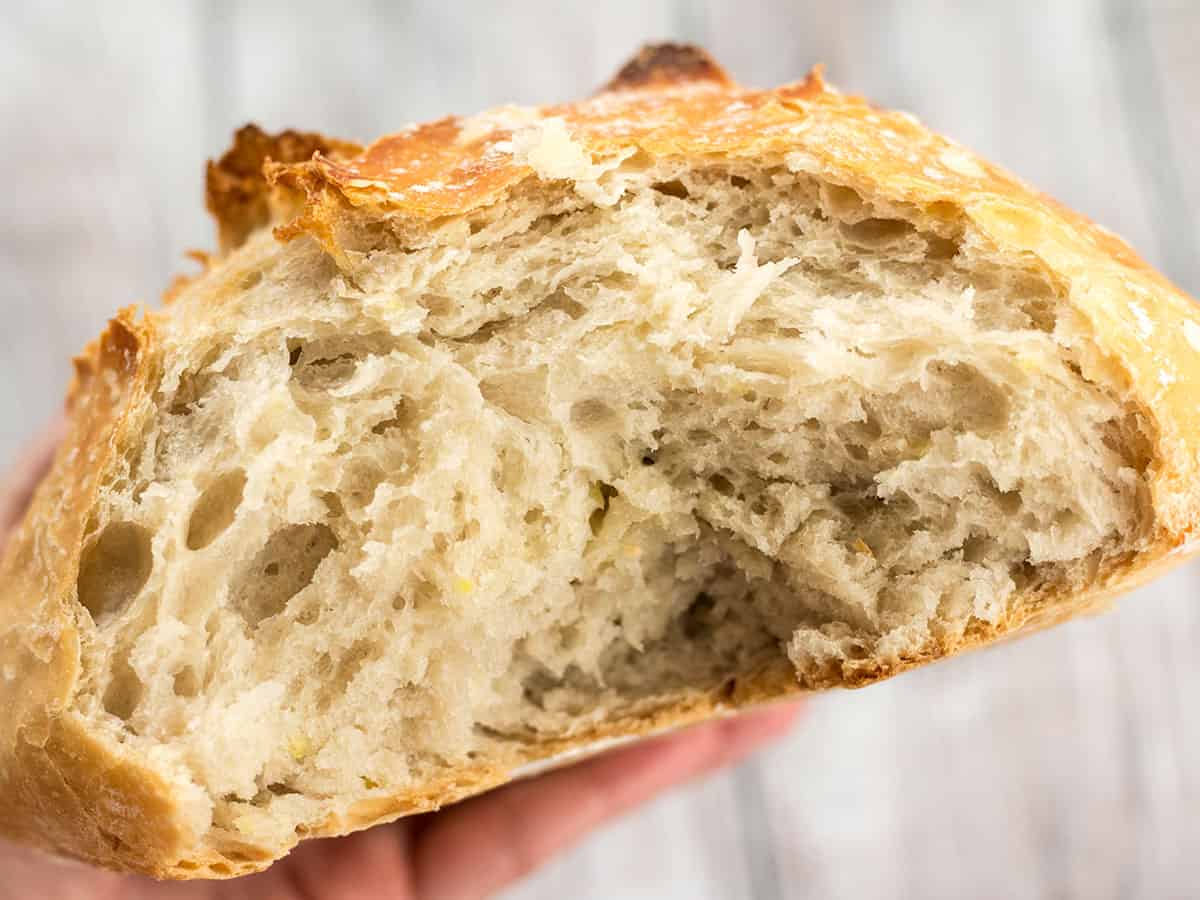
No-Knead Bread
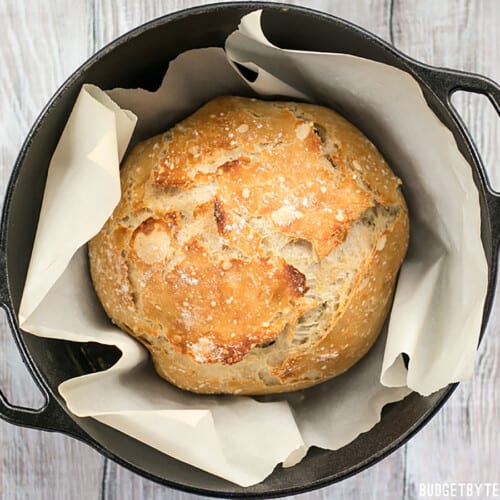
Ingredients
- 3 cups all-purpose flour ($0.29)
- 1/4 tsp instant yeast or bread machine yeast* ($0.02)
- 1.5 tsp salt ($0.02)
- 1.5 to 1.75 cup water** ($0.00)
Instructions
- The day before baking, combine the flour, yeast, and salt in a large bowl and stir until they're well combined. Stir in about 1.5 to 1.75 cups room temperature water until a shaggy, sticky ball of dough forms and there is no dry flour left on the bottom of the bowl. The dough should be wet and sticky, but not so wet that it appears glossy. Cover the bowl loosely with plastic and let it sit at room temperature for 12-18 hours.
- The next day, the dough should be fluffy and very bubbly. When you're ready to bake, sprinkle a little flour on top of the fermented dough and scrape it out of the bowl. With well-floured hands, shape the dough into a ball and place it on a piece of parchment paper. Let the dough rise for 30-60 minutes.
- While the dough is rising, preheat the oven to 425ºF, or the highest recommended temperature listed on the packaging for your parchment paper. Place the Dutch oven inside the oven as it preheats, and make sure it sits in the fully heated oven for at least 15 minutes before baking the bread.
- Once the bread has risen and the Dutch oven is fully heated, carefully remove the Dutch oven from the oven (it will be EXTREMELY hot). Lift the parchment with the dough straight into the dutch oven and cover it with the lid.
- Return the Dutch oven to the oven and bake for 30 minutes. Carefully remove the lid and bake for another 15-20 minutes, or until the crust is a deep golden brown. Remove the Dutch oven from the oven, lift the bread out by by using the parchment paper, and allow it to cool before cutting open and serving.
Sheet Pan Instructions
- Ferment and shape the dough as described above, then place it on a parchment-lined sheet pan to rise for an additional 30 minutes.
- Place a baking pan with about an inch of water on the bottom rack of the oven, then preheat to 425ºF while the dough rises.
- Once the loaf has risen for 30 minutes and the oven is fully preheated, carefully score the top of the dough with a sharp knife (use horizontal motions with no downward pressure). Transfer the sheet pan to the oven and bake for 40 minutes, or until the crust is deeply golden brown and the loaf sounds hollow when tapped.
See how we calculate recipe costs here.
Equipment
- Cast Iron Dutch Oven
- Mixing Bowls
- Parchment Paper
- Liquid Measuring Cup
Notes
Nutrition
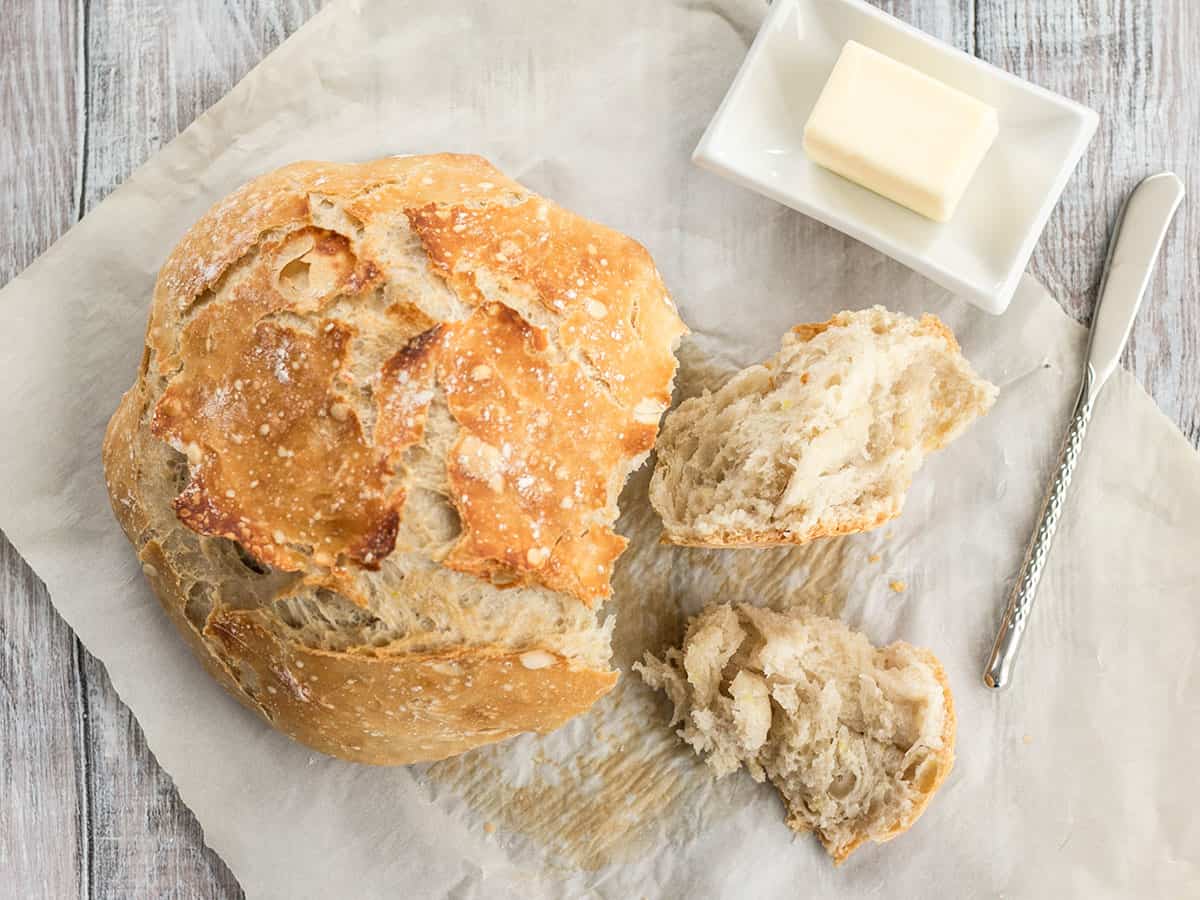
How to Make No-Knead Bread – Step by Step Photos
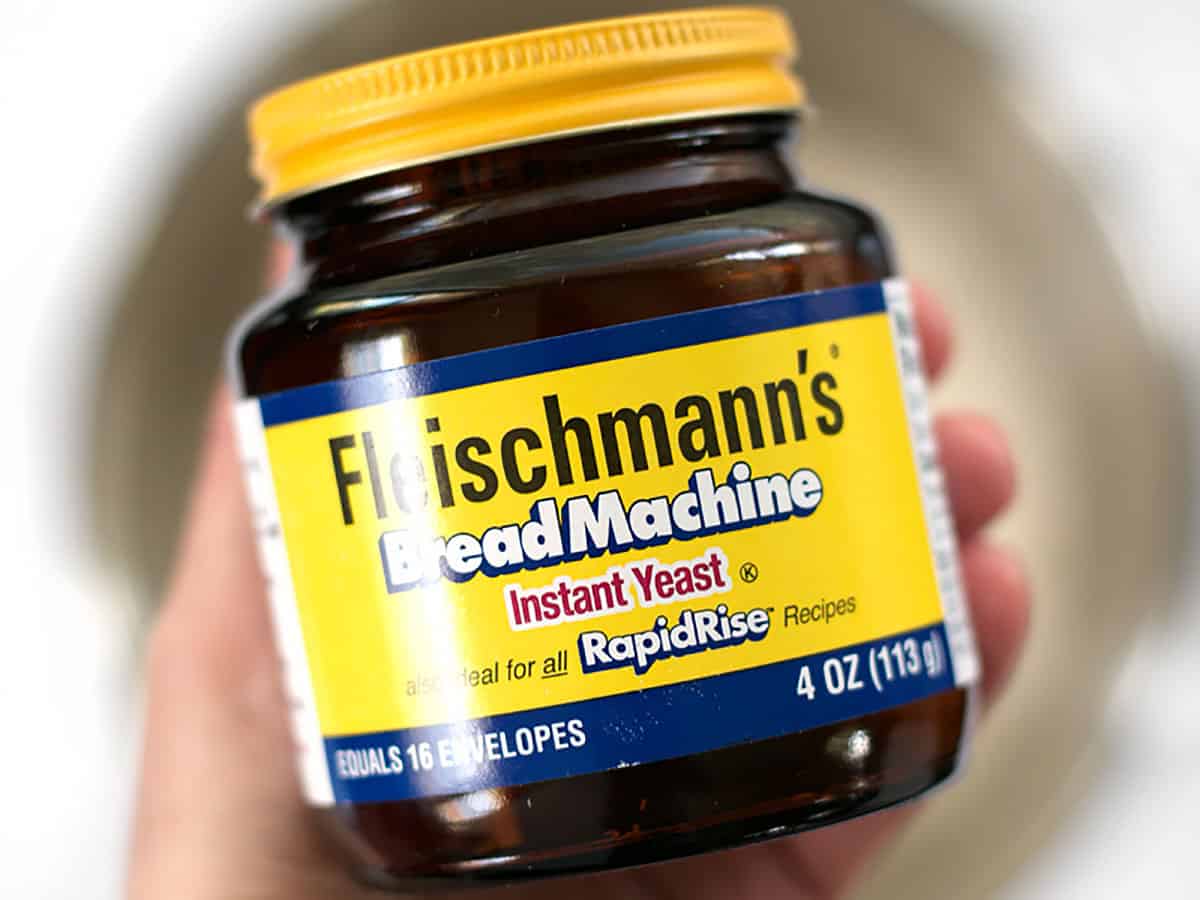
Before you begin, make sure you have “instant yeast” or “bread machine yeast” rather than “active dry”. The reason you need this type of yeast specifically is because it does not need to be kick-started by mixing with warm water first. You can add it to a recipe dry and it will still activate. I buy these little jars, which I keep in my fridge, and they last for-ev-er (especially when you’re only using 1/4 tsp at a time)!
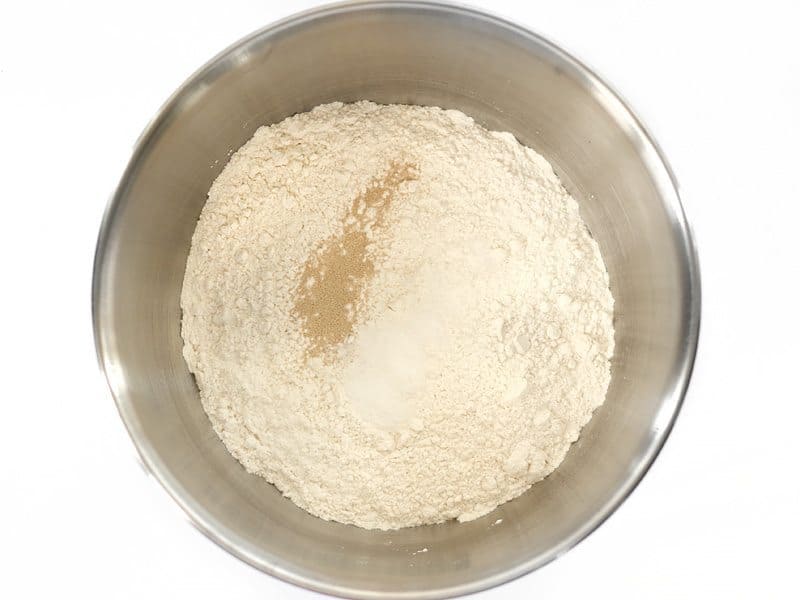
The day before you want to actually bake the bread, combine 3 cups all-purpose flour, 1/4 tsp instant or bread machine yeast, and 1/2 Tbsp salt in a large bowl. Stir them together really well.
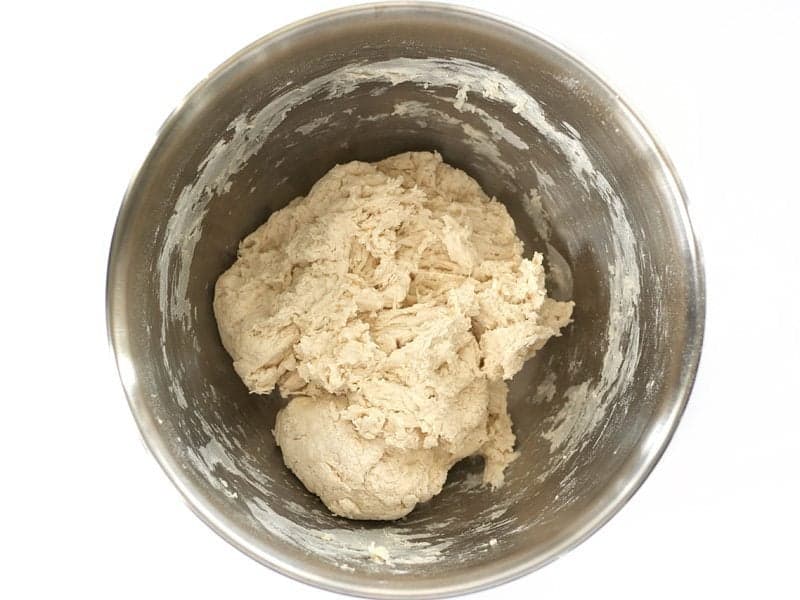
Stir in about 1.5 to 1.75 cups of room temperature water, or just enough to form a shaggy ball of slightly sticky dough, and no dry flour is left on the bottom of the bowl. The total amount of water needed may vary from time to time depending on the ambient humidity and moisture content of the flour, so go on visuals here. Make sure it comes together in one ball and no dry flour is left on the bottom of the bowl. It’s okay for it to be a bit sticky.
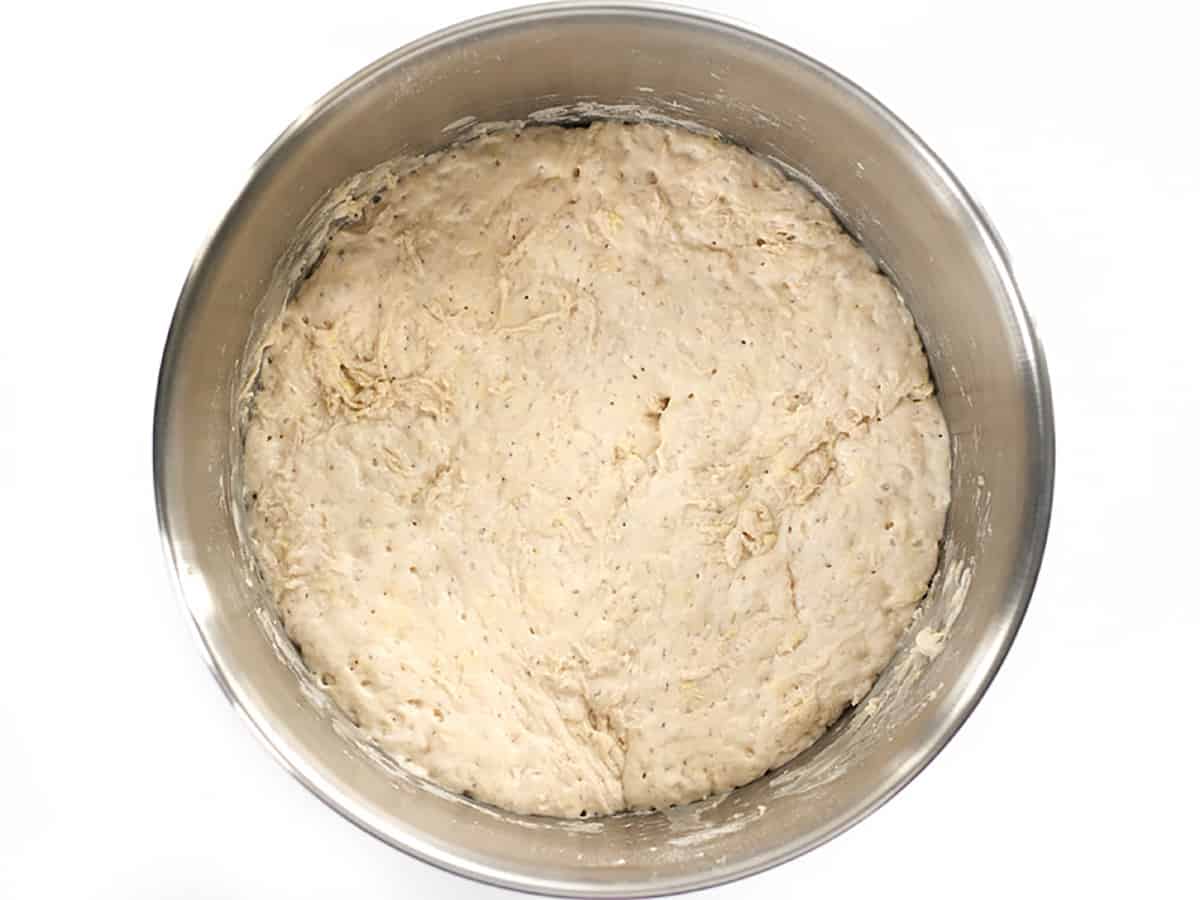
Loosely cover the bowl with plastic and let the dough ferment at room temperature for 12-18 hours. If you need to let it sit longer than that to fit your schedule, just transfer it to the refrigerator. As the dough ferments, it becomes very big, light, fluffy, and bubbly.
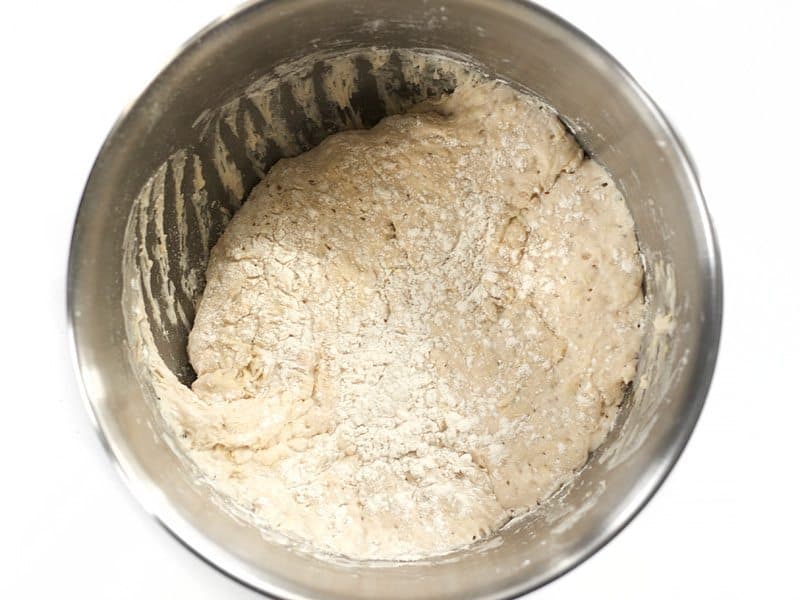
Sprinkle a little flour onto the dough (because it will be sticky) and scrape it out of the bowl. It will begin to deflate as you scrape it out.
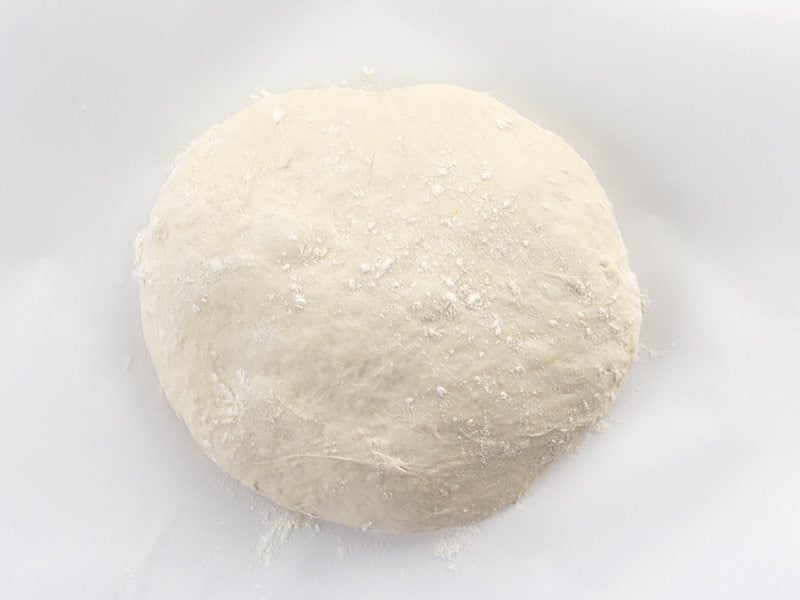
Using floured hands, shape the dough into a ball, then place it on a large piece of parchment. Let the dough rise for 30-60 minutes. The shorter rise time will produce a slightly more dense bread and the longer rise time will have larger bubbles.
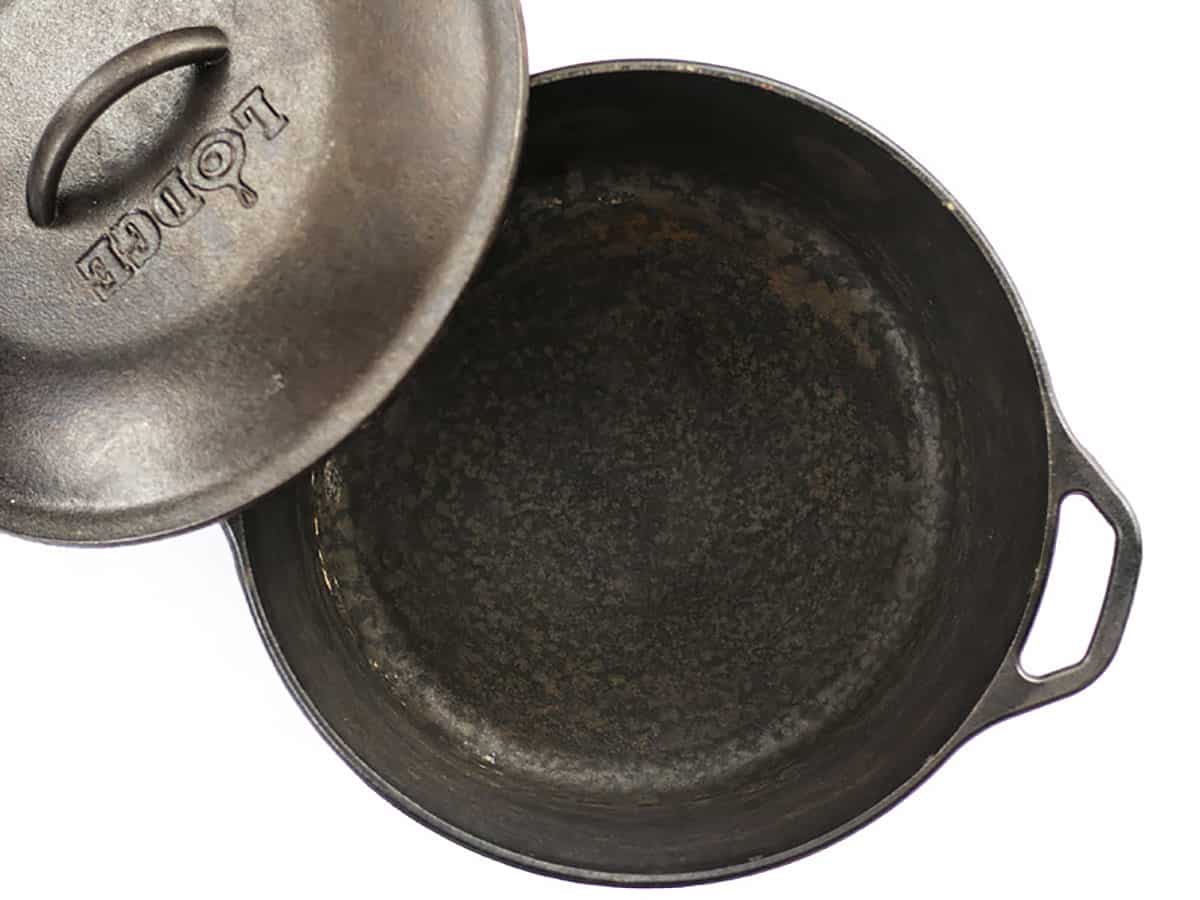
While the dough is rising, begin to preheat the oven and the Dutch oven. Set the oven to 425ºF, or whatever the highest safest temperature is for your brand of parchment (it will usually be listed on the box somewhere). Make sure your Dutch oven is inside the oven as it preheats, and then let it heat for an additional 15 minutes or so once the oven is up to temperature. This makes sure that the Dutch oven is nice and hot.
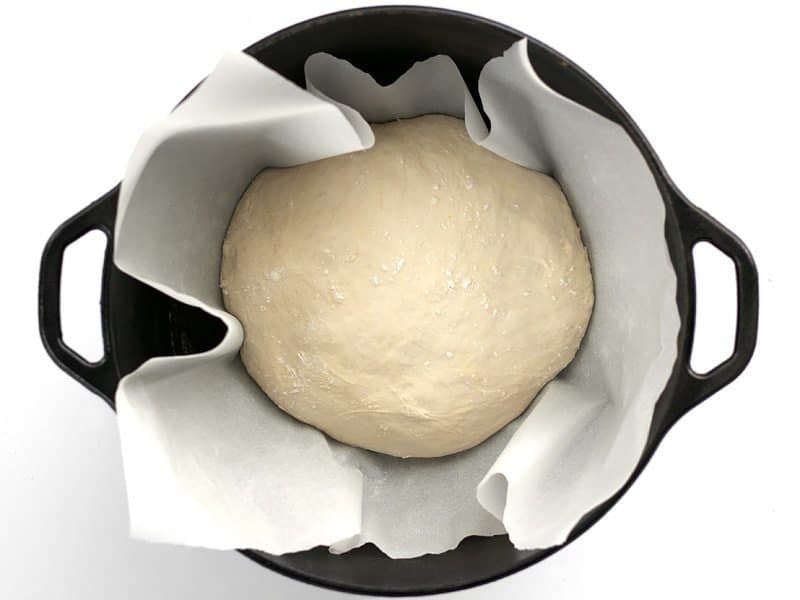
When the dough is risen and the Dutch oven is fully preheated, carefully remove the Dutch oven from the oven (it will be extremely hot!). Lift the risen dough by the parchment and place it inside the Dutch oven, parchment and all. Place the lid on the Dutch oven and return it to the hot oven.
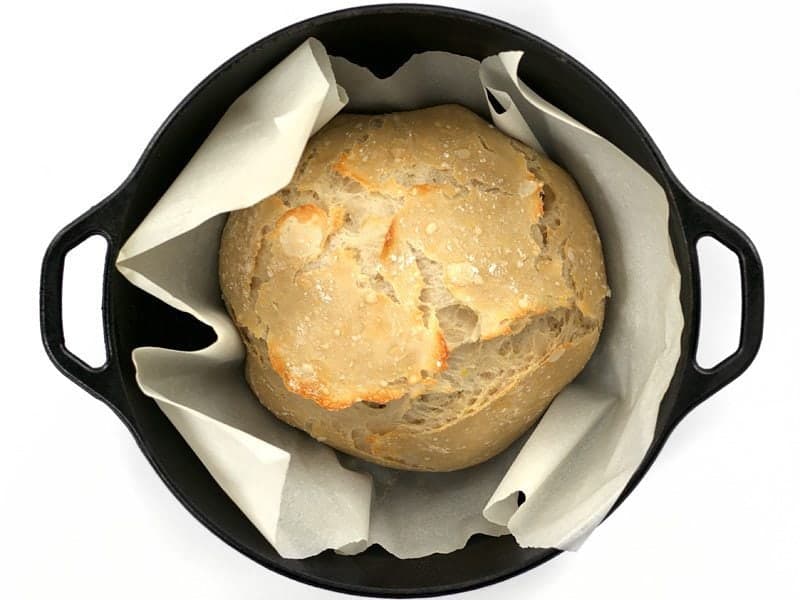
Let it bake for 30 minutes with the lid on the Dutch Oven, then carefully remove the lid…
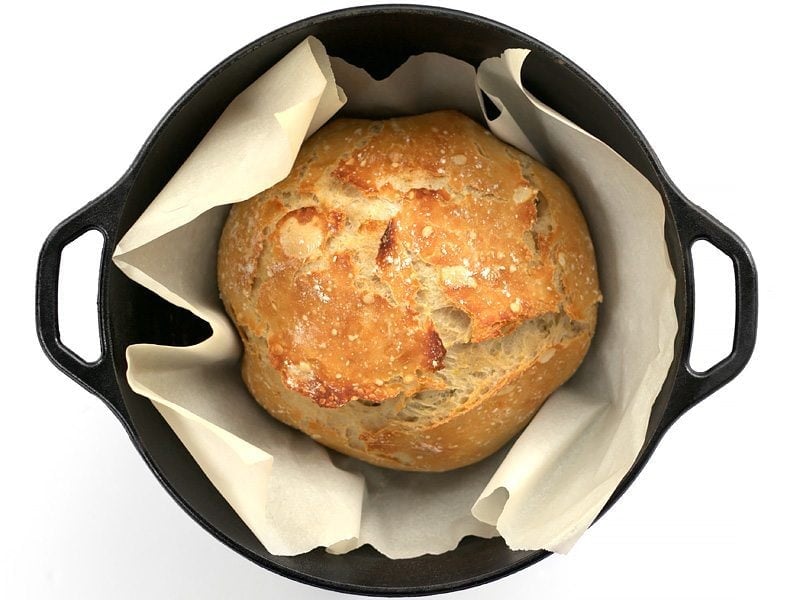
Then bake it for an additional 15 minutes or so WITHOUT the lid to allow the crust to brown.
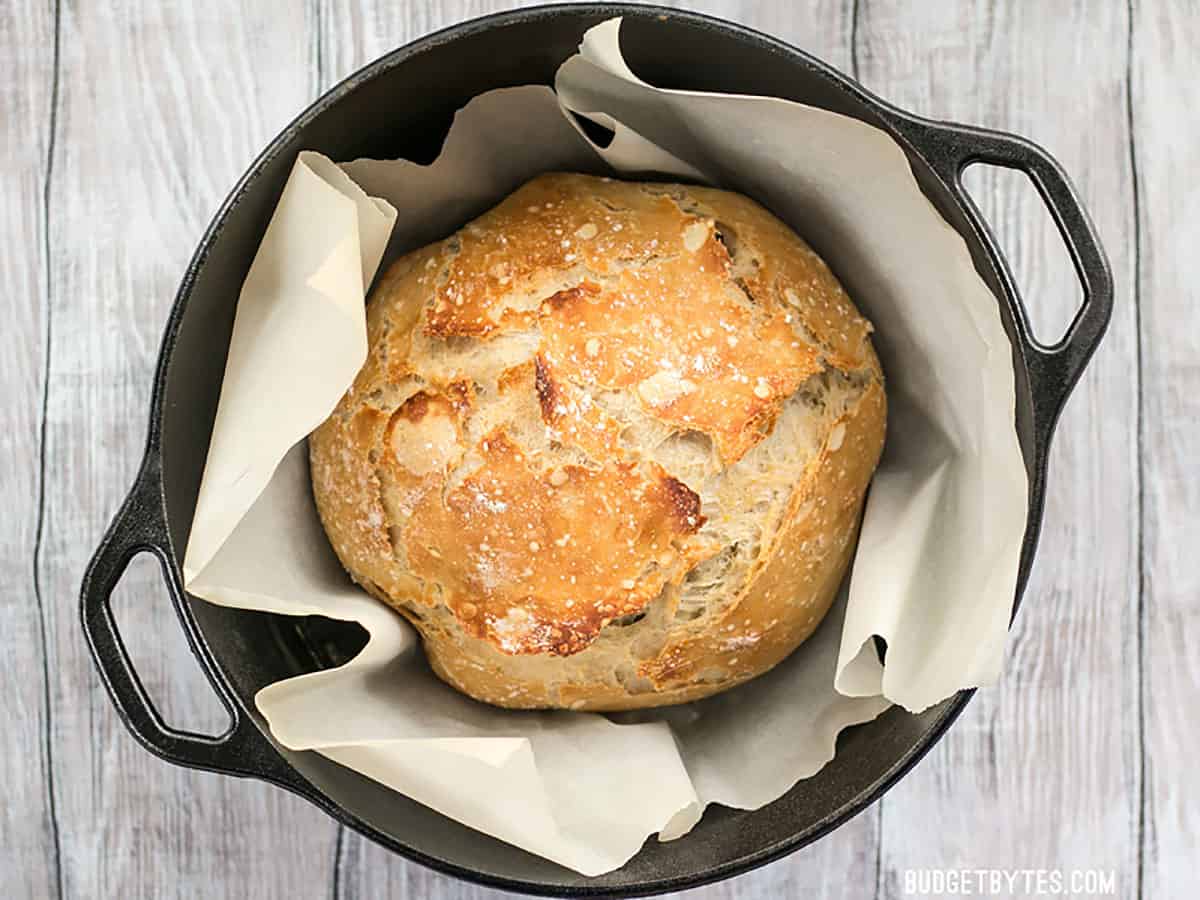
Once the crust achieves a nice deep golden brown color, carefully remove the Dutch Oven from the oven. Lift the no-knead bread out of the Dutch oven by the parchment, and allow it to cool before serving.
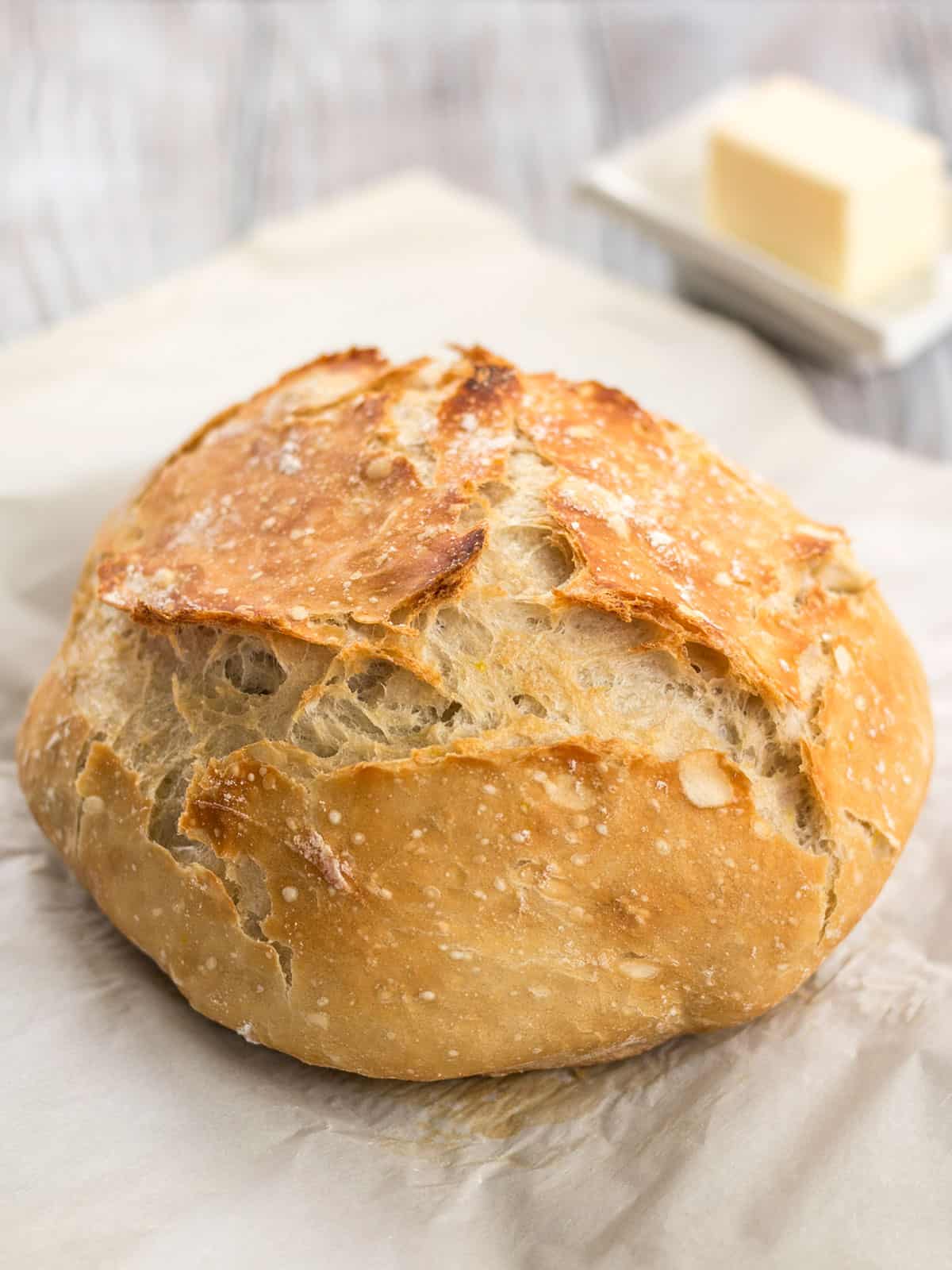
And just be prepared for the BEST bread you’ve ever made yourself. ;) The crust on this no-knead bread is seriously amazing.
No Dutch Oven and Short Fermentation Instructions
So, as I mentioned before, you can still bake this bread without a Dutch oven and with a short, 2-hour fermentation time. Here is a photo of my no-knead bread using just 2 hours of fermentation (plus another 1 hr rise time) and baked on a baking sheet.
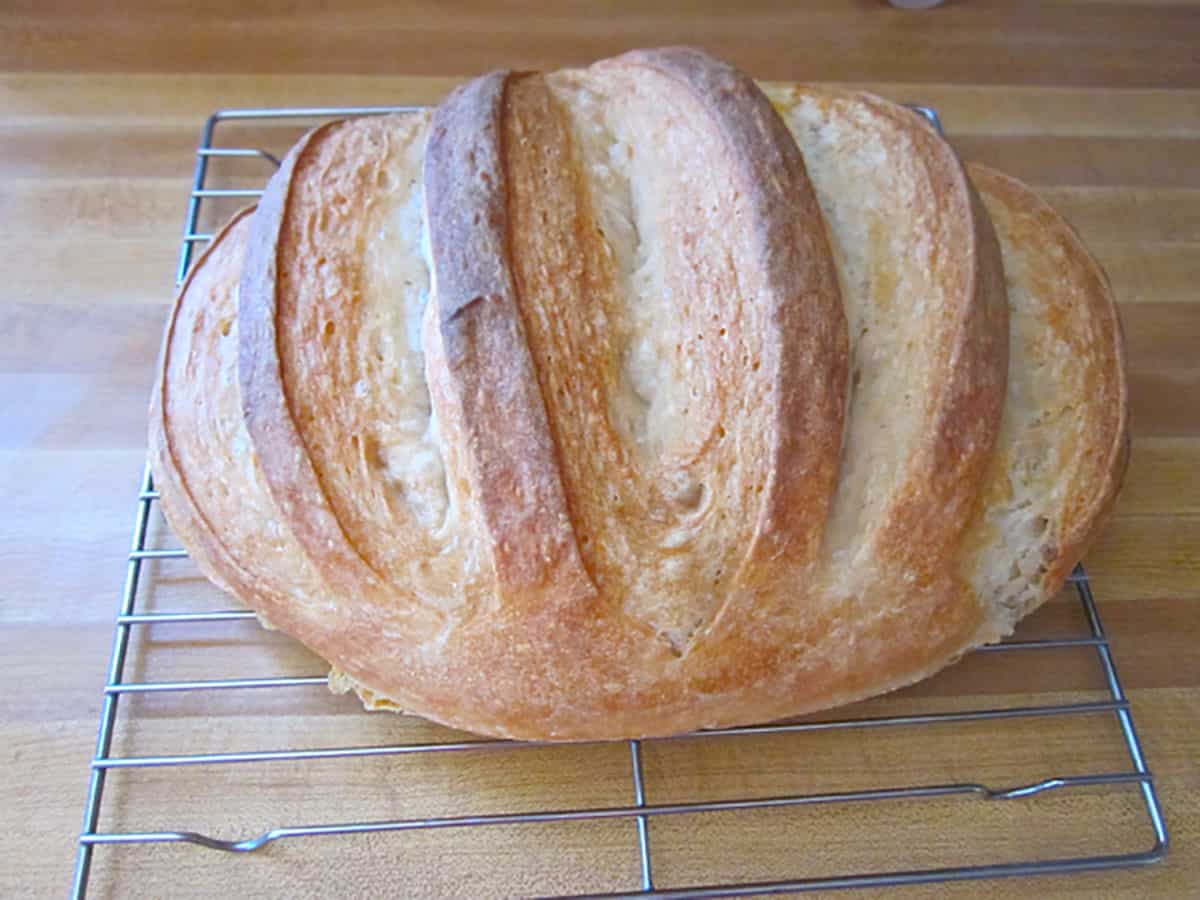
If you only have about 2-3 hours to ferment the dough, you’ll need to increase the amount of yeast used to 2 tsp (instead of 1/4 tsp).
Let the dough ferment in the bowl for 2 hours, then shape it into a loaf, transfer it to a baking sheet covered with parchment (and sprinkled with cornmeal, if desired) and let rise for about another hour. I like to make slits in the top with a sharp knife after the loaf has risen. Be careful though, if the knife is not sharp enough or you use too much downward pressure, it can deflate the dough.
Brush the surface of the dough with water, then bake it in a preheated oven (again, as hot as the parchment will allow, usually around 425ºF) for 30-40 minutes, or until the crust is nicely browned.


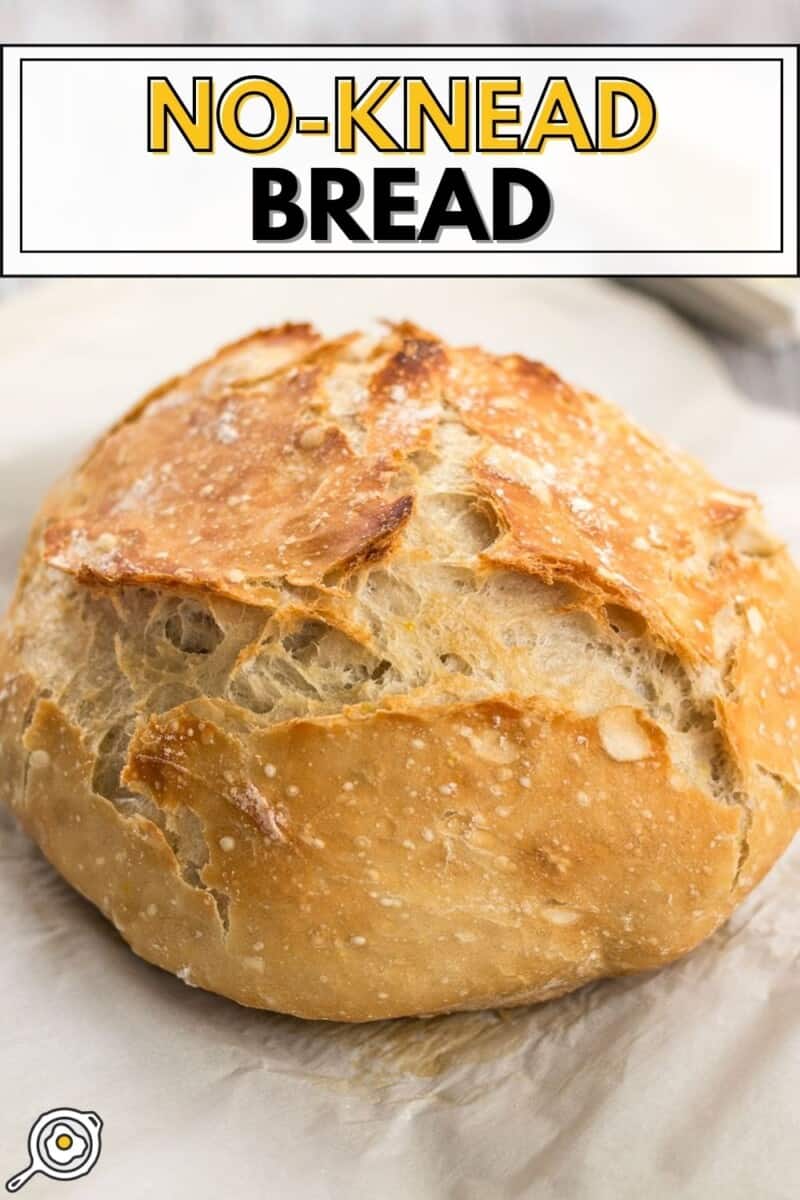
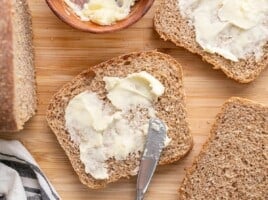
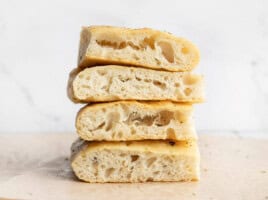
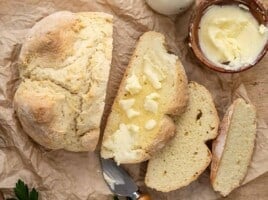
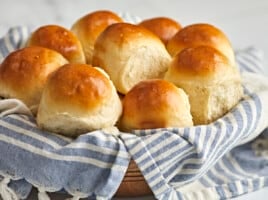
I really want to try this. However, it is now ‘not summer’ here in Minnesota, so room temperature is 68 when it’s warm. Will this affect the fermentation time or the rise time? I know for regular bread making/baking it does.
It might slow it down a bit, so I’d shoot for closer to 18 hours than 12. Check the photos in the step by step section to see what it should look like when it’s ready to bake. :)
If I wanted to alter the recipe to a beer based bread, do I just swap the water with beer? Thoughts/suggestions?
I’ve never made a yeast based beer bread before, so I’m not sure how that would work. All the beer breads I’ve made were quick breads (no yeast).
Do you think this would work with part whole wheat flour?
Yes, I’ve made similar bread with up to half whole wheat. The texture (and strangely the color) do change a bit, but it’s still pretty tasty.
I tried ur recipe yesterday and I made very tasty bread, except the crust in mine didn’t come out that nice like on yours, it was rather difficult to pull apart, I wonder if my Dutch oven is too big for the small bread. Do you think that I could double the amount?
Also great pictures and very easy step by step directions. Thank you.
Yes, you should be able to double the size, although it may need longer to bake.
I love Budget Bytes!
Thanks for all of the great, healthy recipes with easy-to-follow illustrated instructions! I’ve made bread this way MANY times and it’s very simple and foolproof. Sometimes before the last 30-60 minute rising of the dough, I’ll fold in other ingredients, like garlic or nuts…or event a nutty version of trail mix. Sunflower seeds are a great additive too. I also sprinkle a little kosher salt on the top before baking.
Although it’s a good idea, I don’t use the parchment paper but instead sprinkle some corn meal in the bottom of the cast iron dutch oven.
It never sticks. Cast iron cooking is fun…and I’ve started collecting, restoring and using vintage cast iron.
Dear Beth,
I notice that the date on this blog article is 2010, but you noted at the beginning that you had updated the recipe after making it for 6 years, so the new visitor expects that you had started making this bread in 2004 (prior to the Lahey and Hertzberg/Francois no-knead publishing phenomenons!) — but on a different recipe which you noted that you had updated after 5 years, the no-knead ciabatta which has a date of 2010, you put the update date of 2015 in parentheses, so you might want to specify the update date in parentheses (presumably it was in 2016) on this article as well, so it’s less confusing to the new visitor.
You might also want to add back the full version of the original recipe/instructions at the end of the article, because otherwise, a number of the reader comments don’t make sense to the new visitor (where they talk about putting water in an empty pan on a lower shelf of the oven to make steam, etc.)
It is also possible to approximate a dutch oven kind of steaming effect by using an oven-safe metal cooking pot with a lid (one that has all-metal handles and that the manufacturer says its oven-safe — I use a largish, all-metal Calphalon stovetop soup-making pot with a heavy lid to make this sort of no-knead “artisan” bread, and it works well), or even just putting aluminum foil tightly over the baking container for the first part of the baking time keeps some steam in and is worth the effort.
You mentioned in one of your most recent bread recipe articles that you actually don’t eat much bread anymore, and I’m wondering if you have talked about that change in your diet and your reasons why, anywhere on the blog. Of course, that’s a very personal decision and sometimes it comes down to necessity (celiac issues, etc.)
I came here through a link on a different blog that had quoted your recipe for no-knead ciabatta rolls — I am enjoying browsing around your blog — I have had about 20 of your recipe pages open on my browser for the last 2 days! So many good things that I want to try out, when I get some time in the kitchen. :-)
Can we use active dry yeast and get it started with warm water and sugar?
While I’ve thought of testing that method, I haven’t yet tried it. The only issue you might run into is that if you don’t need to use the full amount of water (because the amount can very from time to time) you may also miss some of the yeast that is mixed into it.
Outstanding photos
I’ve had great results baking in a cast iron dutch over BUT without preheating it.
I always found it difficult to get the risen loaf into the pan without hurting myself.
So I tried it and it worked! Would recommend this to anyone.
Sorry I failed to mention that the final rise is IN the cast iron pot itself – so It’s all set to bake without having to transfer it. Also I add 2 Tbls. oil and 2 Tbls. sugar to the dough.
Stirring with the HANDLE of a plastic / wooden spoon also works great rather than the spoon part.
Thanks Dee for sharing the tips. They were very helpful indeed.
On the other hand, thanks Beth for all the wonderful recipes.
Thanks so much! I just brought new yeast since when I started this last night, my yeast was way too old! I will try your recipe tonight when I use my fresh yeast.
I make bread using an almost identical version of this, but do add-ins. Diced jalapeños and cheddar chunks make an incredible loaf!
I don’t think I will ever buy bread at the store again! So easy! Delicious!
Just made this and it was absolutely delicious! Great with jam right out of the oven. Curious though, if I wanted to make this a sweeter bread, by adding sugar, when do you think I would do that? Would I mix it in with everything, or should I mix it with water and yeast and then add? Love to hear your suggestion!
I think I would dissolve it into the water.
I like to make bread like this at home, and I have two specific recipes I blend together to make mine, and at least one of them suggest using a container of water in the oven, but they called for putting the water in the dish/pan heating the water with the rest of the oven. I’ve not had a problem with getting a nice crisp crust when I do it that way, and the interior of the bread is moist but still has a good crumb… not that it lasts very long!
Okay, verdict is in! Great! I can’t believe how easy this was! Made a cool rise French breach recipe the other day that everyone liked, but this is a lot better. Gonna try your focaccia bread next.